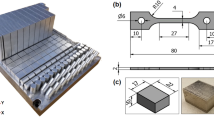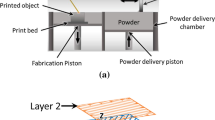Abstract
Increasing powder layer thickness could undoubtedly raise the productivity of the laser powder bed fusion (LPBF) process. On the other hand, it may cause some microstructural side-effects, which in turn influence the mechanical properties of the final part. In this work, the effects of increasing powder layer thickness from 30 to 50 μm were studied on the microstructure, tensile, and creep life of LPBF Inconel 718 (IN718). Microstructural investigations were done by optical microscope, field emission scanning electron microscope, and electron backscatter diffraction. Tensile tests were conducted at room temperature as well as 650 ֯C, and stress-rupture tests were performed in standard incremental mode. The results showed that by using 66% thicker powder layers, the intercellular spacing increased from 480 to 1000 nm and diameter of columnar grains enlarged from 38.6 to 69.3 μm. Also, coarser intercellular particles precipitated in continuous form. These microstructural changes led to slight variations in tensile properties at both room and high temperatures. On the other side, significant changes were observed in the creep life of the samples produced with different layer thicknesses. It was discovered that although the specimens produced with 30 μm layer thickness had 0.82% lower relative density, they exhibited 1.7 times longer creep life compared to those fabricated by 50 μm powder layer thickness. Furthermore, fractography showed the lack-of-fusions(LOFs) were the main crack initiators during the tensile tests, while intergranular cracking due to coalescence of spherical cavities caused the high-temperature failure during creep.
















Similar content being viewed by others
References
Popovich VA, Borisov EV, Popovich AA, Sufiiarov VS, Masaylo DV, Alzina L (2017) Impact of heat treatment on mechanical behaviour of Inconel 718 processed with tailored microstructure by selective laser melting. Mater Des 131:12–22
Shi JJ, Li X, Zhang ZX, Cao GH, Russell AM, Zhou ZJ, Li CP, Chen GF (2019) Study on the microstructure and creep behavior of Inconel 718 superalloy fabricated by selective laser melting. Mater Sci Eng A 765:138282
Choi J-P, Shin G-H, Yang S, Yang DY, Lee JS, Brochu M, Yu JH (2017) Densification and microstructural investigation of Inconel 718 parts fabricated by selective laser melting. Powder Technol 310:60–66
Tucho WM, Cuvillier P, Sjolyst-Kverneland A, Hansen V (2017) Microstructure and hardness studies of Inconel 718 manufactured by selective laser melting before and after solution heat treatment. Mater Sci Eng A 689:220–232
Baicheng Z, Xiaohua L, Jiaming B, Junfeng G, Pan W, Chen-nan S, Muiling N, Guojun Q, Jun W (2017) Study of selective laser melting (SLM) Inconel 718 part surface improvement by electrochemical polishing. Mater Des 116:531–537
Backman DG, Williams JC (1992) Advanced materials for aircraft engine applications. Science 255:1082–1087
Zheng L, Schmitz G, Meng Y, Chellali R, Schlesiger R (2012) Mechanism of intermediate temperature embrittlement of Ni and Ni-based superalloys. Crit Rev Solid State Mater Sci 37:181–214
Popovich VA, Borisov EV, Popovich AA, Sufiiarov VS, Masaylo DV, Alzina L (2017) Functionally graded Inconel 718 processed by additive manufacturing: Crystallographic texture, anisotropy of microstructure and mechanical properties. Mater Des 114:441–449
Raghavan S, Zhang B, Wang P, Sun CN, Nai MLS, Li T, Wei J (2017) Effect of different heat treatments on the microstructure and mechanical properties in selective laser melted INCONEL 718 alloy. Mater Manuf Process 32:1588–1595
Nadammal N, Cabeza S, Mishurova T, Thiede T, Kromm A, Seyfert C, Farahbod L, Haberland C, Schneider JA, Portella PD, Bruno G (2017) Effect of hatch length on the development of microstructure, texture and residual stresses in selective laser melted superalloy Inconel 718. Mater Des 134:139–150
Zhou Y, Wen SF, Song B, Zhou X, Teng Q, Wei QS, Shi YS (2016) A novel titanium alloy manufactured by selective laser melting: microstructure, high temperature oxidation resistance. Mater Des 89:1199–1204
Zhao X, Li S, Zhang M, Liu Y, Sercombe TB, Wang S, Hao Y, Yang R, Murr LE (2016) Comparison of the microstructures and mechanical properties of Ti–6Al–4 V fabricated by selective laser melting and electron beam melting. Mater Des 95:21–31
Montero-Sistiaga ML, Pourbabak S, Van Humbeeck J et al (2019) Microstructure and mechanical properties of Hastelloy X produced by HP-SLM (high power selective laser melting). Mater Des 165:107598
Mancisidor AM, Garciandia F, San Sebastian M et al (2016) Reduction of the residual porosity in parts manufactured by selective laser melting using skywriting and high focus offset strategies. Phys Procedia 83:864–873
Calignano F, Minetola P (2019) Influence of process parameters on the porosity, accuracy, roughness, and support structures of hastelloy X produced by laser powder bed fusion. Materials 12:3178
Yadroitsev I, Krakhmalev P, Yadroitsava I (2014) Selective laser melting of Ti6Al4V alloy for biomedical applications: Temperature monitoring and microstructural evolution. J Alloys Compd 583:404–409
Bartolomeu F, Faria S, Carvalho O, Pinto E, Alves N, Silva FS, Miranda G (2016) Predictive models for physical and mechanical properties of Ti6Al4V produced by Selective Laser Melting. Mater Sci Eng A 663:181–192
Kasperovich G, Haubrich J, Gussone J, Requena G (2016) Correlation between porosity and processing parameters in TiAl6V4 produced by selective laser melting. Mater Des 105:160–170
Kruth J-PP, Badrossamay M, Yasa E, et al (2010) Part and material properties in selective laser melting of metals. In: Proceedings of the 16th international symposium on electromachining. pp 1–12
Wang S, Liu Y, Shi W et al (2017) Research on high layer thickness fabricated of 316 L by selective laser melting. Materials 10:1055
Ma M, Wang Z, Gao M, Zeng X (2015) Layer thickness dependence of performance in high-power selective laser melting of 1Cr18Ni9Ti stainless steel. J Mater Process Technol 215:142–150
Sufiiarov VS, Popovich AA, Borisov EV, Polozov IA, Masaylo DV, Orlov AV (2017) The effect of layer thickness at selective laser melting. Procedia Eng 174:126–134
Zhang B, Dembinski L, Coddet C (2013) The study of the laser parameters and environment variables effect on mechanical properties of high compact parts elaborated by selective laser melting 316 L powder. Mater Sci Eng A 584:21–31
Cutolo A, Neirinck B, Lietaert K, de Formanoir C, van Hooreweder B (2018) Influence of layer thickness and post-process treatments on the fatigue properties of CoCr scaffolds produced by laser powder bed fusion. Addit Manuf 23:498–504
Nath SD, Gupta G, Kearns M, Gulsoy O, Atre SV (2020) Effects of layer thickness in laser-powder bed fusion of 420 stainless steel. Rapid Prototyp J 26:1197–1208
de Souza AF, Al-Rubaie KS, Marques S et al (2019) Effect of laser speed, layer thickness, and part position on the mechanical properties of maraging 300 parts manufactured by selective laser melting. Mater Sci Eng A 767:138425
Shamsdini S, Shakerin S, Hadadzadeh A, Amirkhiz BS, Mohammadi M (2020) A trade-off between powder layer thickness and mechanical properties in additively manufactured maraging steels. Mater Sci Eng A 776:139041
Pröbstle M, Neumeier S, Hopfenmüller J, Freund LP, Niendorf T, Schwarze D, Göken M (2016) Superior creep strength of a nickel-based superalloy produced by selective laser melting. Mater Sci Eng A 674:299–307
Kuo Y-L, Horikawa S, Kakehi K (2017) Effects of build direction and heat treatment on creep properties of Ni-base superalloy built up by additive manufacturing. Scr Mater 129:74–78
Kuo Y-L, Nagahari T, Kakehi K (2018) The effect of post-processes on the microstructure and creep properties of alloy718 built up by selective laser melting. Materials 11:996
McLouth TD, Witkin DB, Bean GE et al (2020) Variations in ambient and elevated temperature mechanical behavior of IN718 manufactured by selective laser melting via process parameter control. Mater Sci Eng A 780:139184
AMS5664F (2017) Nickel alloy, corrosion and heat resistant, bars, forgings, and rings, 52.5Ni - 19Cr - 3.0Mo - 5.1Cb - 0.90Ti - 0.50Al - 18Fe, consumable electrode or vacuum induction melted, 1950 °F (1066 °C) solution heat treated, precipitation hardenable
ASTM E8/E8M(2010) standard test methods for tension testing of metallic materials 1. Annu B ASTM Stand 4:1–27
AMS5662M (2009) Nickel alloy, corrosion and heat-resistant, bars, forgings, and rings 52.5Ni - 19Cr - 3.0Mo - 5.1Cb (Nb)- 0.90Ti - 0.50Al - 18Fe consumable electrode or vacuum induction melted 1775 °F (968 °C) solution heat treated, precipitation-hardenable
Rezaei A, Rezaeian A, Kermanpur A, Badrossamay M, Foroozmehr E, Marashi M, Foroozmehr A, Han J (2020) Microstructural and mechanical anisotropy of selective laser melted IN718 superalloy at room and high temperatures using small punch test. Mater Charact 162:110200
Du D, Dong A, Shu D et al (2019) Influence of build orientation on microstructure, mechanical and corrosion behavior of Inconel 718 processed by selective laser melting. Mater Sci Eng A 760:469–480
Azadian S, Wei L-Y, Warren R (2004) Delta phase precipitation in Inconel 718. Mater Charact 53:7–16
Manikandan SGK, Sivakumar D, Rao KP, Kamaraj M (2015) Laves phase in alloy 718 fusion zone—microscopic and calorimetric studies. Mater Charact 100:192–206
Xu Z, Murray JW, Hyde CJ, Clare AT (2018) Effect of post processing on the creep performance of laser powder bed fused Inconel 718. Addit Manuf 24:486–497
Choo H, Sham K-L, Bohling J, Ngo A, Xiao X, Ren Y, Depond PJ, Matthews MJ, Garlea E (2019) Effect of laser power on defect, texture, and microstructure of a laser powder bed fusion processed 316 L stainless steel. Mater Des 164:107534
Do DK, Li P (2016) The effect of laser energy input on the microstructure, physical and mechanical properties of Ti-6Al-4 V alloys by selective laser melting. Virtual Phys Prototyp 11:41–47
Radhakrishna CH, Rao KP, Srinivas S (1995) Laves phase in superalloy 718 weld metals. J Mater Sci Lett 14:1810–1812
Zhou X, Li K, Zhang D, Liu X, Ma J, Liu W, Shen Z (2015) Textures formed in a CoCrMo alloy by selective laser melting. J Alloys Compd 631:153–164
Thijs L, Luz M, Sistiaga M et al (2013) Strong morphological and crystallographic texture and resulting yield strength anisotropy in selective laser melted tantalum. Acta Mater 61:4657–4668
Sivaprasad K, Raman SGS (2008) Influence of weld cooling rate on microstructure and mechanical properties of alloy 718 weldments. Metall Mater Trans A 39:2115–2127
Guo JT (2008) Materials science and engineering for superalloys. Sci Press, Beijing
Courtney TH (2005) Mechanical behavior of materials. Waveland Press, Illinois
Author information
Authors and Affiliations
Corresponding author
Ethics declarations
Conflict of Interest
The authors declare that they have no conflict of interest.
Additional information
Publisher’s note
Springer Nature remains neutral with regard to jurisdictional claims in published maps and institutional affiliations.
Rights and permissions
About this article
Cite this article
Badrossamay, M., Rezaei, A., Foroozmehr, E. et al. Effects of increasing powder layer thickness on the microstructure, mechanical properties, and failure mechanism of IN718 superalloy fabricated by laser powder bed fusion. Int J Adv Manuf Technol 118, 1703–1717 (2022). https://doi.org/10.1007/s00170-021-07719-7
Received:
Accepted:
Published:
Issue Date:
DOI: https://doi.org/10.1007/s00170-021-07719-7




